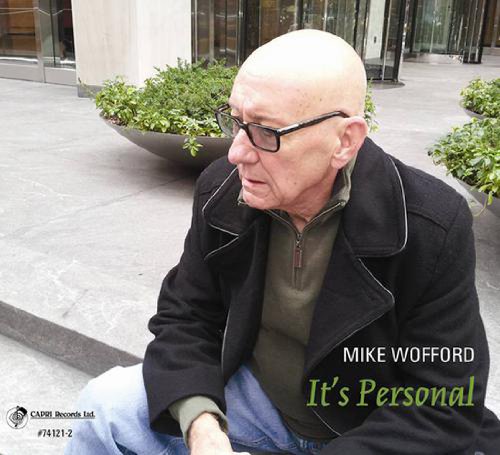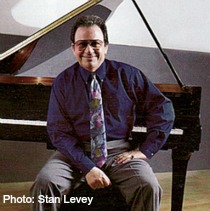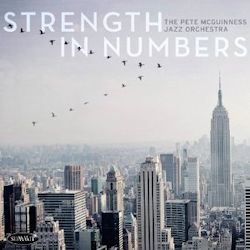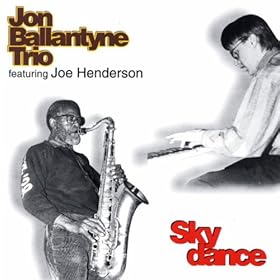While the days of taking a 16-piece band on tour are long over, fortunately record companies and producers continue to issue albums of that genre. Falling into that category is the Pete McGuinness Jazz Orchestra’s Strength In Numbers and it is an acknowledgement that there is a market for a big band that is venturesome and can play with power and precision.
Even before dropping the laser beam on the disc, a reading of the liner notes offered encouragement. One of the producers of the album is John Fedchock who was one of the stalwarts of Woody Herman’s latter bands and is a leader of his own New York based big band and knows a thing or two about the need for swinging arrangements. The Send-Off is the send-off for the album and, while not a barn-burner, it does offer tenor-saxophonist Tom Christensen and drummer Scott Neumann a chance to deftly show their chops. The Michel Legrand chestnut What Are You Doing The Rest Of Your Life?is done up as an easy-going waltz with some smart expressiveness and then part way through, for some unexplained and unfathomable reason, Pete McGuinness offers a vocal. McGuinness does the same vocal thing with You Don’t Know What Love Is justifying it on the basis that Chet Baker was one of his vocal heroes. Sometimes such adulation is best left unrequited.
The balance of the album confirms that McGuinness is a composer and arranger with an invigorating original style who can take advantage of the full palette of a large orchestra as shown on the Stephen Foster ballad Beautiful Dreamer which is turned into a swaying samba with the soprano sax of Dave Pietro layered in over the band. Nasty Blues is a swinger of the first order with the saxophone section laying down the melody in the manner of Count Basie and then the soloists take over, firstly with Dave Pietro on alto, followed by an exchange of choruses by trombonists Mark Patterson and Matt Haviland. The band’s blazing “shout chorus” is led by trumpeter Jon Owens. Finally Bittersweet opens with an extended piano offering from Mike Holober after which McGuinness carries the load on trombone, showing he can deliver the goods in a brusque but evocative style.
This is an invigorating release from a solid outfit.
1. The Send-Off; 2, What Are You Doing The Rest Of Your Life?; 3. Trixie’s Little Girl
4. The Swagger; 5. Beautiful Dreamer; 6. Spellbound; 7. You Don’t Know What Love Is
8. Nasty Blues; 9. Bittersweet; 10. You Don’t Know What Love Is (radio version)
Dave Pietro, Marc Phaneuf, Tom Christensen, Jason Rigby, Dave Reikenberg - Woodwinds
Mike Holober - Piano; Andy Eulau - Bass; Scott Neumann - Drums
Mike Wofford
It's Personal By Amazon
By AmazonMike Wofford has a long history of playing piano with great jazz musicians over the past 50 years including long stints with Shelly Manne, Bud Shank and many others. He is probably best known for his work as accompanist and musical director for Ella Fitzgerald and Sarah Vaughan. His latest recording, It's Personal features Wofford on solo piano playing some of his personal favorite tunes. There are 4 original compositions from Wofford and 8 other pieces by a range of composers from Jackie McLean, Dizzy Gillespie and Duke Ellington to the Talking Heads.
Claudio Filippini Trio
Squaring The Circle By Robin Arends
By Robin ArendsOne of Italy's most talented young jazzpianists, Claudio Filippini, turns back to the jazzstandards in his new album "Squaring the Circle". The album is recorded in october 2013 in Cavalicco and released july this year. Flippini uses unexpected instrumentation. Filippini has left his Nordic Trio (consisting of Palle Daniellson and Olavi Louhivuori) and now takes his comfortable freedom with the artistic soulmates he started his professional carreer with a decade ago.
The album starts with a number called "Impressions" and is subscribed to John Coltrane. It could also be a version of the (frequently by Coltrane interpreted) Rodgers and Hammerstein-composition "My Favorite Things". After a bassintro Filippini's piano and electronics are taking over.
An abundance of echoes and strings do believe that Filippini is going a completely different (let us say: more commercial) direction. Fortunately this proves not to be the case as the next piece testifies.
What follows is a surprising version of "Autumn Leaves", introduced by Di Leonardo and Bulgarelli which turns slowly in a beboptune led by Filipinni. There is little that is reminiscent of the original standard. It is clear that with this second song the trio declares originality is more important than an exact representation of the standard. The other pieces proof us why.
Part of the intro of 'Round Midnight' turns into a Portisheadpiece and could suggest we are in the wrong room but later it turns out that we still sit in the right place. Filippini's Grand Piano is in the centre and plays the wellknown Monktune. After a digital interlude, Monk is put in the closet and Filippini proofs his skills while he is accompanied by samples. Also Filippini's version of the Oliver Nelson-classic "Stolen moments" is a complete remake. It starts as a discosong and ends up as a Brazilian carnivaltune.
The trio distances itself not completely from the originals. The uptempo Hart and Rodgers composition "I Dont' Know What Time It Was" keeps pretty near the original version. Also Mancini's "Moon River" stays mainly intact. And the trio Filippini leave us in silence with a breathtaking version of the evergreen "What a Wonderful World".
All together "Squaring the Circle" is not just about qualities. It is about inventive creativity. It is alluring to compare the pieces on this album with the music on the other Filippini-albums or versions of other pianists. Why fits "As Time Goes By" better on "Breathing in Unison" and what makes the presented standards unique? What is the difference between Filippini's version of Jitterbug Waltz and Errol Garners 1949- version? Can we compare Autumn Leaves or 'Round Midnight as played by the master of standardspecialist Keith Jarret? Yes, we can and we'll hear different voices, unique souls playing unique tunes. All together Squaring the Circle is too short. There are many other tunes which could be included in this selection. "Impressions" should be left to McCoyTyner and maybe Marc Copland and Dave Liebman (and compare it with the Copland-trio version of My Favourite Things). But there is so much more we have a right to. Where are the compositions of Kern, Berlin, Gershwin and Hammerstein? The qualities of Filippini and his trio should not be limited to the numbers on this album. We want more!
Tracks:
1. Impressions (J. Coltrane) 5:53
2. Autumn Leaves (F. Prévert – J. Kosma) 4:55
3. 'Round Midnight (B. Hanighen – T. Monk – C. Williams) 7:59
4. I Don't Know What Time It Was (L. Hart – R. Rodgers) 4:32
5. Moon River (J. Mercer – H. Mancini) 5:19
6. Stolen Moments (O. Nelson) 4:00
7. Jitterburg Waltz (F. Waller) 6:09
8. A Night In Tunisia (D. Gillespie) 6:15
9. What A Wonderful World (B. Thiele – G. D. Weiss) 7:06
Personnel:
Claudio Filippini, piano & keyboards
Luca Bulgarelli, bass
Marcello Di Leonardo, drums
Fred Hersch
Solo By Fred Kaplan
By Fred KaplanWith Solo, his 49th album as a leader (or co-leader) and 10th as a soloist, Fred Hersch nails his standing as one of the premier jazz musicians of our time, a pianist of subtle touch and propulsive flow, something like Keith Jarrett but more focused, less rhapsodic—Ravel to KJ's Liszt or Rachmaninoff (not that there's anything wrong with either).
Recorded live last year at the Windham Civic Center Concert Hall, in New York's Hudson Valley, Solo (on the Palmetto label), features, like most of Hersch's albums, a mix of originals and standards—the latter by Jobim, Ellington, Monk, and Joni Mitchell, four composers who have no finer interpreters in jazz today.
Monk is a particularly knotty composer to cover. Most pianists who try either come off as merely imitative (and usually stiff) or go for an original approach that doesn't sound remotely Monkish. Hersch, as he first demonstrated on Thelonious (a 1997 album on Nonesuch), is among the few who mines Monk's essence while refining it in an original voice. He embroiders Jobim with newfound layers of beauty, adds a Latin flavor to Ellington's "Caravan," and lays down Mitchell's "Both Sides Now" with loving (but not at all sentimental) elegance.
I'd say this is Hersch's best solo album since In Amsterdam (2006) or maybe Let Yourself Go (1999).
About the sound quality. A reviewer in one of the other audio magazines (not Stereophile) gave this album 5 stars for sonics, which, I must report, is absurd. It was recorded on a standard 44.1kHz/16-bit CD-R by the Windham Civic Center's sound man (unnamed in the credits), who gave Hersch the disc after the concert. Hersch hadn't planned to release it as an album, but he was so taken by his performance—and so unmoved by a studio session he'd laid down around the same time—that he decided to put out the Windham session, despite the so-so sound. He gave the disc to Mark Wilder, one of the top mastering engineers around, who brought out his bag of tricks and made it sound as good as possible—but good is the best he could do. It's a bit reverberant and a bit muffled, but better than you'd expect from a raw feed off a soundboard. Let's call it 4½ stars for music, 3 stars for sound.
Don't let this put you off, though. The beauty of Hersch's playing shines through.
Dino & Franco Piana Ensemble
Seasons By TraccediJazz Magazine
By TraccediJazz MagazineDino e Franco Piana, a circa due anni di distanza presentano un nuovo lavoro. A differenza del precedente questo è costruito su una sequenza di nove brani uniti tra loro da modulazioni e cadenze di largo respiro.
Franco Piana con questo lavoro si rivela compositore ed arrangiatore di altissimo livello, la sua scrittura per sei fiati (flicorno, tromba, trombone, saxalto, saxtenore, flauto) pianoforte, contrabbasso e batteria è costruita, in modo da ottenere quei risultati che solo un orchestratore/arrangiatore di valore riesce a realizzare.
Alla scrittura di Franco può, agevolmente, adattarsi quanto il critico accademico Winthrop Sergeant disse a proposito di Gil Evans: “grande senso della poesia sonora e puntigliosa attenzione ai colori timbrici”. Ma ciò che maggiormente sorprende è la capacità di Franco Piana nel creare “masse di suono” con solo sei strumenti a fiato, lui stesso al flicorno, la tromba Fabrizio Bosso, Dino Piana, trombone, Ferruccio Corsi e il giovanissimo figlio Lorenzo Corsi, rispettivamente saxalto e flauto e Max Ionata, sax tenore, insieme a Enrico Pieranunzi, pianoforte, Giuseppe Bassi, contrabbasso e Roberto Gatto, batteria e produttore artistico, vale a dire in questo “nonet”, alcune fra le più belle realtà del Jazz di oggi.
Nel primo dei nove brani “Opening” eseguito da tutti i fiati, vengono già enunciati gli spunti tematici dei brani che seguiranno. Nel secondo, “Just a Reflection”, dopo un tema molto articolato seguono i primi quattro assolo dovuti a Max Ionata, Fabrizio Bosso, Dino e Franco Piana. Dopo un ensemble e ad Enrico Pieranunzi segue un “collettivo tematico” prima delle parti solistiche di Roberto Gatto e Franco Piana.
Dopo la ripresa del tema e una modulazione che porta ad una cadenza splendidamente eseguita al flauto da Lorenzo Corsi, viene introdotto il terzo brano “A Light in the Dark”. Già in “Just a Reflection” la parte in assolo di Fabrizio Bosso appare in tutta la sua versatilità, così quella di Pieranunzi che esplora ogni peculiarità della composizione.
Il tema di “A Light in the Dark” è esposto magistralmente da Dino Piana e Ferruccio Corsi, cui segue Enrico Pieranunzi la cui personalità stilistica originale è qui in tutta evidenza. Dopo una modulazione, una cadenza di Dino Piana ne introduce una ulteriore di pianoforte le cui ultime note sono quelle del nuovo tema “Five Generations”, brano che si sviluppa tra la prima parte modale e l'inciso costruito su giro armonico.
Le parti solistiche sono riservate a Max Ionata sempre espressivo nel suo bel fraseggio, Fabrizio Bosso e Enrico Pieranunzi. La composizione si chiude con una bella “chase” fra Giuseppe Bassi solido e swingante e Roberto Gatto sempre elegante ed efficace. Gli assolo di Ionata, Bosso e Pieranunzi in sequenza sono straordinariamente inventivi e di grande impulso ritmico.
Nel quinto brano ”After the Winter” dopo un’introduzione che riprende il tema finale del “movimento” precedente, Lorenzo e Ferruccio Corsi, flauto e saxalto, espongono, dopo la modulazione, questa splendida melodia di Franco Piana lasciata per l'intera esecuzione al lirismo di Lorenzo e Ferruccio. “After the Winter” termina con intervalli di un tono e ½ tono e annuncia il brano seguente “Ostinato” in cui si notano una sequenza di assolo splendidi: Pieranunzi, Ionata, una chase superba eseguita da Dino Piana e Lorenzo Corsi, Fabrizio Bosso, Giuseppe Bassi e infine Franco Piana che con la tromba sordinata, chiude questa sesta composizione anticipando “Only Now”.
Il brano si apre con un dialogo fra i fiati ed un assai brillante Roberto Gatto, che è anche produttore artistico del cd, prosegue poi con una sequenza di assolo, Bosso e Ionata prima dell’ensemble, Dino e Franco Piana, Enrico Pieranunzi prima del collettivo che precede il tema. L’ottava composizione “Why Not” è, anche in questo caso, un tema melodicamente di grande efficacia, esposto con intensità da Franco al flicorno e da Dino, seguiti da Enrico Pieranunzi. La modulazione finale con flauto, flicorno e trombone prevede intervalli che anticipano
il 9° movimento finale, un blues veloce, “CdJ Blues” (dedicato alla Casa del Jazz di Roma). “CdJ” è impostato secondo la classica struttura jazz di sempre, ma sempre efficace, tema-assolotema, quando, come in questo caso, i solisti sono di altissima classe e capacità.

















